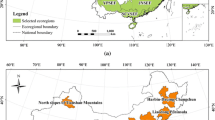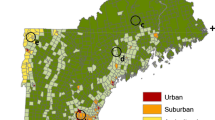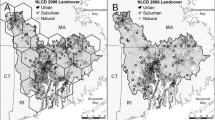Abstract
Impervious surfaces degrade urban water quality, but their over-coverage has not explained the persistent water quality variation observed among catchments with similar rates of imperviousness. Land-cover patterns likely explain much of this variation, although little is known about how they vary among watersheds. Our goal was to analyze a series of urban catchments within a range of impervious cover to evaluate how land-cover varies among them. We then highlight examples from the literature to explore the potential effects of land-cover pattern variability for urban watershed management. High-resolution (1 m2) land-cover data were used to quantify 23 land-cover pattern and stormwater infrastructure metrics within 32 catchments across the Triangle Region of North Carolina. These metrics were used to analyze variability in land-cover patterns among the study catchments. We used hierarchical clustering to organize the catchments into four groups, each with a distinct landscape pattern. Among these groups, the connectivity of combined land-cover patches accounted for 40 %, and the size and shape of lawns and buildings accounted for 20 %, of the overall variation in land-cover patterns among catchments. Storm water infrastructure metrics accounted for 8 % of the remaining variation. Our analysis demonstrates that land-cover patterns do vary among urban catchments, and that trees and grass (lawns) are divergent cover types in urban systems. The complex interactions among land-covers have several direct implications for the ongoing management of urban watersheds.








Similar content being viewed by others
Explore related subjects
Discover the latest articles and news from researchers in related subjects, suggested using machine learning.References
Alberti M, Booth D, Hill K, Coburn B, Avolio C, Coe S, Spirandelli D (2007) the impact of urban patterns on aquatic ecosystems: an empirical analysis in puget lowland sub-basins. Landsc Urban Plan 80:345–361
Arnold CL Jr, Gibbons CJ (1996) Impervious surface coverage: the emergence of a key environmental indicator. J Am Plan Assoc 62(2):243–358
Bailey RG (1995) Southern mixed forest province. UDSA Forest Service Descriptions of the Ecoregions of the United States, http://www.fs.fed.us/colormap/ecoreg1_provinces.conf?662,326. Accessed 4 Dec 2012
Bannerman RT, Owens DW, Dodds RB, Hornewer NJ (1993) Sources of pollutants in Wisconsin stormwater. Water Sci Technol 28(3):241–259
Bechtel B, Micheal F, Mills G, Ching J, See L, Alexander P, O’Connor M, Albuquerque T, Andrade MF, Brovelli M, Das D, Fonte CC, Petit G, Hanif U, Jimenez J, Lackner S, Liu W, Perera N, Rosni NA, Theeuwes N, Gal T (2015) CENSUS of cities: LCZ classification of cities (Level 0). ICUC9—9th International conference on urban climate jointly with 12th symposium on the urban environment
Bigsby K, McHale MR, Hess GR (2013) Urban morphology drives the homogenization of tree cover in Baltimore, MD and Raleigh, NC. Ecosystems 17:212–227
Bolund P, Hunhammar S (1999) Ecosystem services in urban areas. Ecol Econ 29:293–301
Boone CG, Cadenasso ML, Grove JM, Schwarz K, Buckley GL (2009) Landscape, vegetation characteristics, and group identity in an urban and suburban watershed: why the 60s matter. Urban Ecosyst 13:255–271
Booth DB, Jackson CR (1997) Urbanization of aquatic systems: degradation thresholds, stormwater detection, and the limits of mitigation. J Am Water Resour Assoc 33(5):107–109
Booth DB, Hartley D, Jackson R (2002) Forest cover, impervious-surface area, and the mitigation of stormwater impacts. J Am Water Resour Assoc 38(3):835–845
Brabec E, Schulte S, Richards PL (2002) Impervious surface and water quality: a review of current literature and its implications for watershed planning. J Plan Lit 16:499–514
Cadenasso ML, Pickett STA, Schwarz K (2007) Spatial heterogeneity in urban ecosystems: reconceptualizing land-cover and a framework for classification. Front Ecol Environ 5(2):80–88
Carle MV, Halpin PN, Stow CA (2005) Patterns of watershed urbanization and impacts on water quality. J Am Water Resour Assoc 41(3):693–708
Cheng Z, McCoy EL, Grewal PS (2014) Water, sediment, and nutrient runoff from urban lawns established on disturbed subsoil or topsoil and managed with inorganic or organic fertilizers. Urban Ecosyst 17:277–289
Clark SE, Kelly SA, Spicher J, Siu CYS, Lalor MM, Pitt R, Kirby JT (2008) Roofing materials’ contributions to storm-water runoff pollution. J Irrig Drain Eng 135(5):638–645
Congalton RG (1991) A review of assessing the accuracy of classifications of remotely sensed data. Remote Sens Environ 37:35–46
Davis AP, Shokouhian M, Ni S (2001) Loading estimates of lead, copper, cadmium, and zinc in urban runoff from specific sources. Chemosphere 44:997–1009
Environmental Protection Agency (2005) National management measures to control nonpoint source pollution from urban areas (EPA Publication 841-B-05-004). U.S. Environmental Protection Agency Office of Water, Washington, DC
Fisher D (2012) America’s fastest-growing cities. Forbes Business Online, http://www.forbes.com/sites/danielfisher/2012/04/18/americas-fastest-growing-cities/2/. Accessed 4 Dec 2012
Göbel P, Dierkes C, Coldeway WG (2007) Storm water runoff concentration matrix for urban areas. J Contam Hydrol 91:26–42
Grove JM, Cadenasso ML, Burch WR Jr, Pickett STA, Schwarz K (2006) Data and methods comparing social structure and vegetation structure of urban neighborhoods in Baltimore, Maryland. Soc Nat Resour 19:117–136
Hatt BE, Fletcher TD, Walsh CJ (2004) The influence of urban density and drainage infrastructure on the concentrations and loads of pollutants in small streams. Environ Manage 34(1):112–124
Jones CR, Christopher CC (1987) Impacts of watershed urbanization on stream insect communities. J Am Water Resour Assoc 23(6):1047–1055
King RS, Baker ME, Whigham DF, Weller DE, Jordan TE, Kazyak PF, Hurd MK (2005) Spatial considerations for linking watershed land-cover to ecological indicators in streams. Ecol Appl 15(1):137–153
Li S, Gu S, Liu W, Han H, Zhang Q (2008) Water quality in relation to land use and land-cover in the Upper Han River Basin, China. Catena 75:216–222
McGarigal K, Marks BJ (1995) Fragstats: spatial pattern analysis program for quantifying landscape structure, USDA General Technical Report PNW-GTR-351
McGarigal K, Cushman SA, Ene E (2012) FRAGSTATS v4: spatial pattern analysis program for categorical and continuous maps. University of Massachusetts, Amherst. http://umass.edu/landeco/research/fragstats/fragstats.html
Nowak DJ, Greenfield EJ (2012) Tree and impervious cover change in U.S. cities. Urban For Urban Green 11:21–30
Paul JM, Meyer JL (2001) Streams in the urban landscape. Annu Rev Ecol Syst 32:333–365
Pickett STA, Cadenasso ML, Grove JM, Groffman PM, Band LE, Boone CG, Burch WR Jr, Grimmond CSB, Hom J, Jenkins JC, Law NL, Nilon CH, Pouyat RV, Szlavecz K, Warren PS, Wilson MA (2008) Beyond urban legends: an emerging framework of urban ecology, as illustrated by the Baltimore ecosystem study. Bioscience 58(2):139–150
Pitt R, Field R, Lalor M, Brown M (1995) Urban stormwater toxic pollutants: assessment, sources, and treatability. Water Environ Res 67(3):260–275
Potter KM, Cubbage FW, Blank GB (2004) A watershed scale model for predicting non-point pollution risk in North Carolina. Environ Manag 34(1):62–74
Pratt B, Chang H (2012) Effects of land-cover, topography, and build structures on seasonal water quality at multiple scales. J Hazard Mater 209–210:48–58
Ridd MK (1995) Exploring a VIS (vegetation-impervious surface-soil) model for urban ecosystem analysis through remote sensing; comparative anatomy for cities. Int J Remote Sens 16(12):2165–2185
Rohe MM (2011) The research triangle: from tobacco road to global prominence. University of Philadelphia Press, Philadelphia
SAS (2012) Principal component analysis, http://support.sas.com/publishing/pubcat/chaps/55129.pdf. Accessed 4 Dec 2012
Schiff R, Benoit G (2007) Effects of impervious cover at multiple spatial scales on coastal watershed streams. J Am Water Resour Assoc 43(3):712–730
Schueler T (1994) The importance of impervious. Watershed Prot Tech 1(3):100–111
Schueler TR, Fraley-McNeal L, Cappiella K (2009) Is impervious cover still important? Review of recent research. J Hydrol Eng 14(4):309–315
Shandas V, Alberti M (2009) Exploring the role of vegetation fragmentation on aquatic conditions: linking upland riparian areas in puget sound lowland streams. Landsc Urban Plan 90:66–75
Walsh CJ (2004) Protection of in-stream biota from urban impacts: minimize catchment imperviousness or improve drainage design? Mar Freshw Res 55:317–326
Walsh CJ, Papas PJ, Crowther D, Sim PT, Yoon J (2004) Stormwater drainage pipes as a threat to a stream-dwelling amphipod of conservation significance, Austrogammarus Australis, in South-Eastern Australia. Biodivers Conserv 13:781–793
Zampella RA, Procopio NA, Lanthrop RG, Dow CL (2007) Relationship of land-use/land-cover patterns and surface-water quality in the Mullica River Basin. J Am Water Resour Assoc 43(3):594–604
Zhu WX, Dillard ND, Grimm NB (2004) Urban nitrogen biogeochemistry: status and processes in green retention basins. Biogeochemistry 71:177–196
Acknowledgments
We thank the National Science Foundation for their support of this research through the Triangle, NC, Urban Long Term Research Area—exploratory award (BCS-0948229). We thank Gary Blank, Kayleigh Somers, Heather Cheshire, Emily Bernhardt, Kevin Bigsby, and Sarah Bruce for their various contributions to this project. The cities of Raleigh, Durham, and Chapel Hill/Carrboro helped immensely through the sharing of spatial data and resources.
Author information
Authors and Affiliations
Corresponding author
Rights and permissions
About this article
Cite this article
Beck, S.M., McHale, M.R. & Hess, G.R. Beyond Impervious: Urban Land-Cover Pattern Variation and Implications for Watershed Management. Environmental Management 58, 15–30 (2016). https://doi.org/10.1007/s00267-016-0700-8
Received:
Accepted:
Published:
Issue Date:
DOI: https://doi.org/10.1007/s00267-016-0700-8




